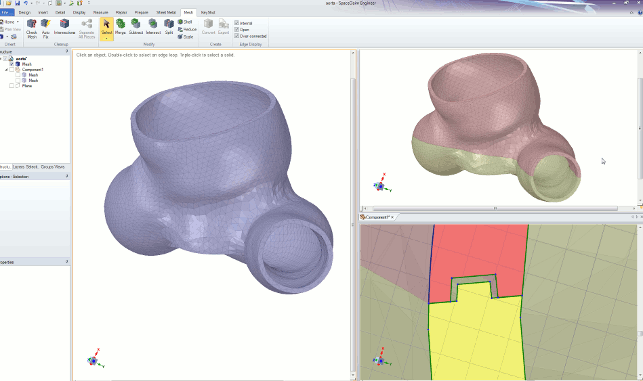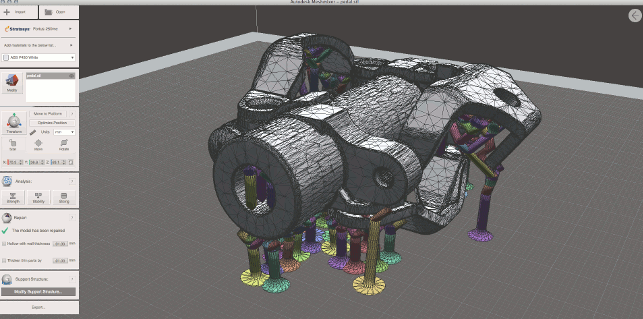“Get off the bandwagon and put down the handbook” sang Arctic Monkeys. Their singer hit the headlines for his speech at the Brits, but Al Dean thinks 3D tool vendors should pay more attention when it comes to 3D printing
It only seems right that we finish off our 3D printing issue with a back page article that addresses one of the major issues that’s facing the industry at present. The issue is that most of the software out there is crap at supporting this fascinating technology to build parts out of, figuratively speaking, nothing at all.

Materialise Magics is a killer App for 3D printing but it costs
Let’s face it. 3D printing is over hyped – of that, there’s very little doubt. But it’s also incredibly useful for professional designers and engineers. A fact that most of us have been aware of for the last two decades or more.
What I’ve noticed in the last year or so is that more 3D software vendors are talking about it. It’s begun infiltrating user events and press conferences, and is starting to pop up in webinars and case studies. 3D printing is a hot topic and the software vendors are trying to make the most of it.
What’s interesting is that the vast majority have, until recently, completely ignored it. When it was an output process from their 3D design systems, they treated it as pretty much that. If they supported a half decent STL output that wasn’t 20 per cent flipped triangles or an over bloated, plain text ASCII file, then they were happy. Job done.
Of course, now the tables have been turned. The 3D print industry is getting the headlines and headlines that the software vendors are, in some cases, downright jealous of. When did you last see the CEO of a 3D design software company on the cover of Wired magazine? When did you last see Jeremy Paxman staring baffled at a NURBS model on Newsnight?
Easy now tiger
From the perspective of the user and one with a decent amount of experience, I can understand why they’re so keen to jump on the bandwagon.
If you can associate your products with a technology that’s hitting the mainstream outside of your traditional community, then you stand a better chance of reaching those that you’ve not before.
My issue with this activity is that there doesn’t seem to be a lot of substance to much of it. Yes, the 3D tools are essential to build the geometry that’s to be printed. That much we all know. But when a company is linking that, but without following up on providing better tools, more support and understanding the workflow and issues that surround the professional user, you can’t help but think it’s all a bit of a con. The good news is that things are starting to change.
Lip service vs real tools
In the last year or so, we’ve seen the mainstream 3D software vendors start to add in tools that better support the process of 3D printing.
Anyone that’s played with one of these machines will know that it’s not simply a case of loading up your 3D part and hitting print. There’s a layer of preparation involved.
You need to orient the model, ensure that the features you’re trying to build are appropriate for the machine or process you’re building on. Yes, in many respects, the ultimate is the ability to hit print and get a geometrically exact replica of what’s on screen.

SpaceClaim’s 3D Print Prep module brings new tools
The reality is that it’s a more involved process. Each machine and material has it’s own requirements in terms of geometry. When you then factor in aspects such as shrinkage, post processing, resizing of holes, adding support to tap holes — some adaptation is always needed.
This has typically been the preserve of the set-up software for each machine. Sizing and orientation are typically handled with ease on a part level. If you then need to look at adding support for thin walls, for resizing of holes and such, then it’s down to the generating software — i.e. your CAD system.
It’s been a pain in the arse and something that comes with experience.
More intelligent tools
Now we’re seeing tools to support these processes and more introduced into our 3D design systems.
SpaceClaim has a whole module that covers some of the basics, Autodesk has recently updated its free MeshMixer tool to bring in not only sizing and orientation tools based on real machine profiles, but also support optimisation and generation. There’s also talk of greater support coming in SolidWorks 2015.

Autodesk MeshMixer – solid tools, for free
Alongside this, there’s a range of specialised tools that also have these type of tools. These have been long adopted by users ‘in the know’.
One of the leading lights is Magics, by Materialise. This system has such mastery of the whole process that it’s a thing to behold. Will these specialist vendors leverage the hype in the same way or bring out more economically viable tools for the average user rather than the hardcore user? I do hope so.
If we’re to put up with the hype and the endlessly entertaining questions from friends and family, then we might as well get some benefit on a professional basis at the same time.
The hype. It’s annoying. But can be beneficial after all.
3D software vendors should pay more attention when it comes to 3D printing
Default






